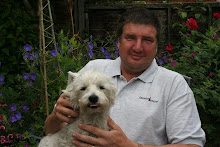 |
Red currant bush stripped of all fruit from ground to the
height an adult turkey hen can reach. |
There is a technique which is a big part of gardening which you won't find so described in any gardening book - "Savannah-ing". This is our word for what is probably called 'raising the skirts'. When we get a shrub, bush or tree up to a decent height we prefer to clear the ground tight around it and cut away all the shaggy, leafless bottom branches to let a bit of light in under it so that its shape resembles one of the trees or thorn bushes in the African Savannah (or trees in a 'Capability Brown' landscape) and has a browse line. Up to now we have had to do this ourselves with secateurs and the hand fork.
 |
No saw-fly this year but the turkeys did a good job of
stripping these goose-gogs of their leaves. |
Step forward the adult turkeys, Tom and (particularly) Barbara who turn out to be quite keen to do this themselves especially on any fruit bushes they come across. We have a row of them in the Kitchen Garden which regular readers may know we call the "Jam and Chutney Hedge" (aka Jam and Jerusalem Hedge) and we have never had a problem before with chickens, but we now have red currant bushes stripped of all fruit below a couple of feet in height while the fruits were still green.
 |
| Well protected strawberries. |
The gooseberry bushes are all below 2 feet at the moment, so they have lost all their fruit (while still hard and immature) and most of their leaves, like the worst kind of saw-fly attack. The poor little fig tree is also fruitless. We do not want to fence this whole area off again (and anyway, turkeys are great fliers and wall-jumpers), so we are looking at letting these bushes grow into a "standard" shape - the lollipop format used for roses, to see if we can get them to do all their fruit up above turkey height. Meanwhile we fenced the birds completely out of the strawberry bed when we caught the turkey parading around and, again, pecking at hard green fruit. We then caught her pushing her head and neck so far through the 2 inch chicken wire to reach more fruit, that she was bulging the fence, so we had to add another 'layer' of fence. Thus protected, the fruits are now ripening and we were able to taste our first strawberries today.
 |
| Tree protection against geese. |
The geese, meanwhile, give us a rather different problem in the orchard. Geese are stronger, tougher birds with toothed beaks and an obsessive nature. They will try a few pecks at the young bark of your new fruit trees and if they find it tears or breaks, they will keep at it, returning to it like a terrier with a stick, worrying it so that the hole gets bigger and bigger. Quickly they will ring-bark the tree. We have tried plastic spiral tree guards which are cheap and work for a while but eventually they become brittle or the tree grows enough to burst the spirals open, exposing bits of bark which is still young enough to be interesting to geese.
 |
| We got some fruit through to 'ripe'! |
Some of our trees are in full sized sheep guards from the first year, when it was sheep we were fending off. (Sheep are a whole different story, as their damage is browsing as well as leaning heavily on the tree and rubbing to try to relieve an itch). Our best solution for the rest and one which, were I writing the book on keeping fruit trees safe from geese I would describe, is a cylinder of 1" weld-mesh (aviary mesh). The stuff we use is 90 cm (yes, sorry about the mixed units) tall which is taller than a goose at full stretch and the one inch mesh is too small for a goose to get even a beak through. The stuff lasts for ever and certainly for longer than it takes the bark within to become too old and gnarly for geese at which point you could still take it off and use the collar for another young tree. This stuff may be expensive but these are just bits left over from when I was building rabbit runs many moons ago.
 |
| One of the new Guineas (left) and a 6 week old turkey (r) |
In other bird news, a few pics of the kindergarten. Turkeys #1 and #2 (Christmas and Noel?) are now 6 weeks old and starting to tower over the new Guinea Fowl. They are also starting to out-grow the rabbit run they are in and look keen to get out amongst it, free ranging. We will probably let this happen in another week or so when we feel a bit more confident that they will not fall prey to the young cat 'Soldier'. Turkeys #3 and #4 ('Janus' and 'Hugh' apologies to any Terry Wogan fans. Don't ask) are now 2 weeks old and starting to outgrow their first brooder-crate, so we need to scrounge a couple more big potato-crisp boxes and move them on a stage, but they have to stay under heat for the first 4 weeks.
 |
| OneChick is now 8 weeks old. |
'OneChick' (as we have named the chick of 'Hen with One Chick') is now 8 weeks old and has started becoming independent from Mum. You do still see them together but you also see the chick just mingling with the rest of the flock and both of these now sleep in the main coop, Mum having decided of her own accord to move house from her little nest next to the camping toilet about a week ago. She looks to us like a hen, which is good news, she can be our replacement for the Sussex Ponte we lost recently.
 |
| The two chicks at 3 weeks old. |
The two chicks of 'Hen and Two' are now 3 weeks old exactly. They look well and healthy and seem to be thriving. They are feathering up well. The buff-coloured one looks like he/she may be another pure-bred Buff Orpington but the white one is probably either a Sussex Ponte hybrid or even a Hubbard cross. We kept 2 hens out of one of the batches of Hubbards (a red and a white, the 2013 birds) to see how they would end up and be egg-layers. They are definitely part of the gang and are regularly 'trodden' by our roosters. Time will tell.
 |
Examining an old frame of ivy honey now being cleaned
by bees in the swarm box. |
Finally, in the bees dept, we have had a good amount of interest in the swarm box so that I wondered if a colony had actually moved in. I needed to examine the box for queen and new brood; if we found these the colony would need moving from the swarm box to the new hive before they got too well established (and started to build their own comb in the box). Well, no worries in fact (and a bit of disappointment; I would have quite liked a 2nd colony). There were 100+ bees in the box and it was busy but these are just 'robber' bees exploiting an undefended source of stored honey. I don't think they are my bees - the flight path is straight south away from the box, not nipping across the 30 feet to our hive. They are there in force cutting away the cappings on the honey comb and nibbling all the solid honey out. I should be left, in a few weeks with some nice clean 'drawn' comb which I can re-use if ever I do get a second colony. That may well be next year by now, the swarm season seem to be over. Never say never, of course; these ladies can swarm as late as October if they are desperate enough.











No comments:
Post a Comment